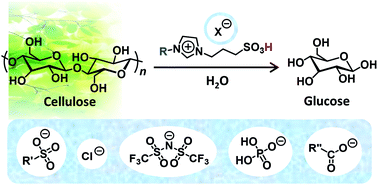Brønsted acidic ionic liquids for cellulose hydrolysis in an aqueous medium: structural effects on acidity and glucose yield†
Abstract
The conversion of cellulose into valuable chemicals has attracted much attention, due to the concern about depletion of fossil fuels. The hydrolysis of cellulose is a key step in this conversion, for which Brønsted acidic ionic liquids (BAILs) have been considered promising acid catalysts. In this study, using BAILs with various structures, their acidic catalytic activity for cellulose hydrolysis assisted by microwave irradiation was assessed using the Hammett acidity function (H0) and theoretical calculations. The glucose yields exceeded 10% when the H0 values of the BAIL aqueous solutions were below 1.5. The highest glucose yield was about 36% in 1-(1-octyl-3-imidazolio)propane-3-sulfonate (Oimps)/sulfuric acid (H2SO4) aqueous solution. A long alkyl side chain on the imidazolium cation, which increased the hydrophobicity of the BAILs, enhanced the glucose yield.



 Please wait while we load your content...
Please wait while we load your content...